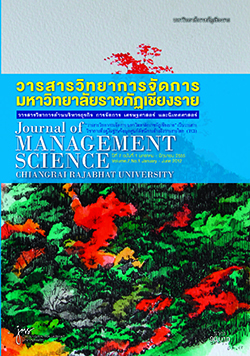A Study of Market Development Strategies for Products in the Border-trade Area, Chiang Rai Province
Main Article Content
Abstract
The aims of this research are to study the market conditions, problems, and the needs of a marketing development strategies in Chiang Rai; to find a group of target goods and a type of goods that has a high possibility to compete with trading partner countries, including China, Laos, and Myanmar; and to find ways to develop marketing strategies for the border trade of the Chiang Rai province. The study from a group of border traders and border trade related authorities shows that fruit processing product is an appropriate targeted product group to be use as a case study to determine marketing strategy for border trade. Border trade marketing development strategies for agricultural goods are (1) achieving marketing objectives, including high quality Chiang Rai’s agricultural goods especially fruit, both fresh and processing under a unique logo that portrays high quality and culture. (2) Target market is separate in two groups: main target market is China and secondary target market is included Laos and Myanmar. (3) The fruit market development strategies that are set by the need level of operators under the main marketing mix includes marketing channels, products, promotions, prices, personnel development, research and development. Furthermore, product differentiation is a driving force in the developing Chiang Rai’s fruit market. Product differentiation is a key to create a competitive advantage and help maintain market share. To dominate the market, the collaboration from all related sectors is extremely important.
Article Details
Views and opinions expressed in the journal do not necessarily reflect those of the editors.


